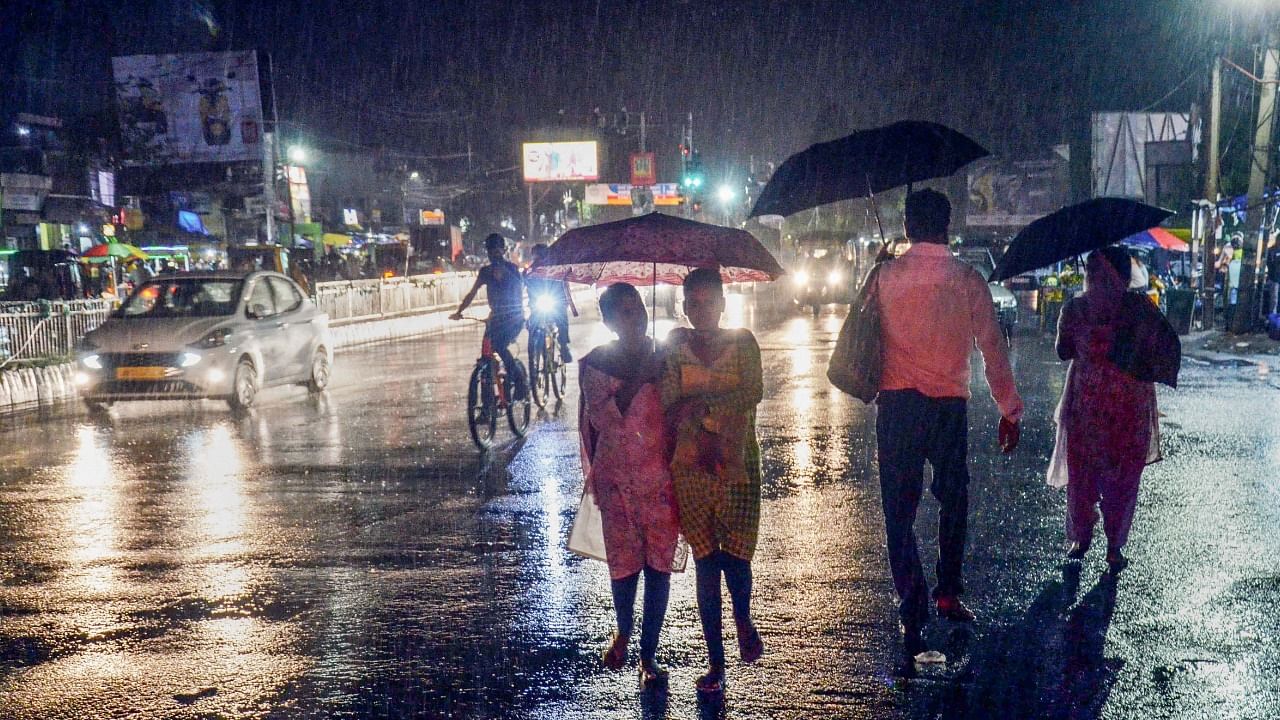
After much weakening, Cyclone Gulab to intensify into another cyclone by Oct 1: IMD
The remnants of Cyclone Gulab are likely to enter the Arabian Sea on September 30 and intensify into a cyclonic storm a day later and then move towards Pakistan, the India Meteorological Department (IMD) said on Wednesday.
Many areas in Gujarat are likely to receive rainfall due to the remnants of Cyclone Gulab.
The IMD said a low pressure area -- a remnant of Cyclone Gulab -- was formed over south Gujarat region and adjoining Gulf of Khambhat on Wednesday morning.
"It is very likely to move west-northwestwards, emerge into northeast Arabian Sea and intensify into a depression by tomorrow (September 30).
The IMD said light to moderate rainfall at most places with heavy to very heavy falls at a few places and extremely heavy falls at isolated places is very likely over Saurashtra and Kutch in Gujarat.
Heavy to very heavy and extremely heavy falls at isolated places are likely over Gujarat region, Daman, Diu, Dadra and Nagar Haveli and heavy to very heavy falls at isolated places over north Konkan.
Light to moderate rainfall at most places with heavy to very heavy falls at isolated places is very likely over Saurashtra and Kutch and heavy falls at isolated places over Gujarat region and north Konkan, the IMD added.
Water logging on a road after heavy rains due to Cyclone Gulab effect, in Thane.
Credit: PTI Photo
Cyclone Gulab damages Indian crops just before harvesting
Heavy rains brought by cyclone Gulab damaged India's summer-sown crops such as soybeans, cotton, pulses and vegetables just before harvesting in key growing regions, which could reduce production and lift prices, industry officials told Reuters.
Lower production could force India, the world's biggest importer of edible oils and pulses, to increase overseas purchases of these commodities, and it could also reduce cotton exports from the world's top producer.
Cyclone Gulab, which originated in the Bay of Bengal, made landfall on the east coast on Sunday and then weakened to a deep depression that brought heavy rainfall to the southern states of Andhra Pradesh and Telangana and western states of Maharashtra and Gujarat.
Cyclone Gulab remnants likely to result in rainfall in Gujarat
The remnants of Cyclone Gulab are likely to enter the Arabian Sea on September 30 and intensify into a cyclonic storm and then move towards Pakistan, the India Meteorological Department (IMD) said on Wednesday.
Many areas in Gujarat are likely to receive rainfall due to the remnants of Cyclone Gulab. (PTI)
IMD forecasts cyclonic storm off Guj coast, asks fishermen not to venture into sea till Oct 2
Commuters travel through a waterlogged road under the rain in Kolkata
12 gates of Manjara dam closed after water discharge causes flooding in 3 Marathwada districts (PTI)
Cloudy skies likely in Delhi
Delhi is likely to see partly cloudy skies for the next two days, but no rainfall is predicted, according to the India Meteorological Department.
In the absence ofrains, the maximum temperaturehas increased by a few notchesover the last three-four days.
It is predicted to settle around36 degrees Celsius on Wednesday. Delhi recorded a minimum temperature of 26.7 degrees Celsius in the morning. (PTI)
IAF helicopter rescues 3 people stranded in Maharashtra's flooded Latur village (PTI)
Intense rain, gusty wind likely to continue over Kolkata, North & South 24 Pargans, East & West Midnapur, Jhargram, Howrah, Hooghly, East & West Midnapur, East, West Bardhaman, Birbhum districts of Bengal during next 3-4 hours: IMD
Mumbai, Thane received heavy to very heavy rainfall in the last 24 hours
Intense showers likely in Mumbai, Thane, Palghar, Raigad in the next 3-4 hours
Local,long distance trains running as per time table so far despite rains in suburban, ghat sections of Mumbai division
Heavy downpour lashes Maharashtra, leaves several areas waterlogged
Two swept away in separate rain-related incidents in Telangana
At least two persons lost their lives in rain-related incidents over the past 24 hours in Telangana, even as the IMD warned that heavy rain is very likely to occur at isolated places in Adilabad, Nirmal, Nizamabad and Kamareddy districts on Tuesday.
(PTI)
Odisha braces for another low pressure after Cyclone Gulab
Barely hours after the remnant of Cyclone Gulab crossed the Odisha skies, the state is bracing up for another low pressure which is likely to dump by heavy rains in the state prompting the authorities to issue warnings to the districts and asking fishermen to return from the sea.
Low pressure area over western India likely to intensify, bring heavy rains in Gujarat, Maharashtra: IMD
After bringing intense rainfall over the eastern coast and central India, Cyclone Gulab weakened into a low pressure area on Tuesday, but it is again likely to intensify further after reaching the western coast, the India Meteorological Department (IMD) said.
The depression over southwest Vidarbha and neighbourhood moved west-northwestwards and weakened into a well-marked low pressure area on Tuesday, the Cyclone Warning Division of the IMD.
It is likely to move northwestwards and weaken gradually during the next 24 hours.
(PTI)
Heavy rains, lightning kill 13 in Maharashtra; over 560 people rescued
Over 12 to 14 people have died in the last days as the Cyclone Gulab-triggered flash-floods swept parts of the Marathwada region and its neighbouring areas in Maharashtra.
The adjacent Vidarbha region too received heavy rainfall - resulting in inundation at several places.